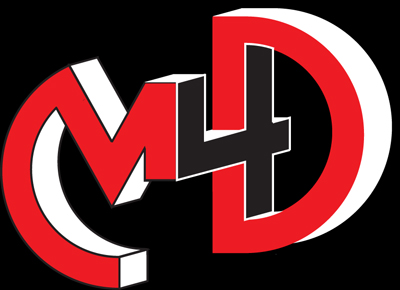Steering
Surprisingly, steering mechanism is not in our scope. In fact, most good cars today use rack-and-pinion steerings whose designs are more or less the same. What makes one car's steering superior to another is the weight distribution, drivetrain system and suspension geometry etc.Steering Response
We always said mid-engined cars are superior in handling. Some ignorant auto journalists interpret as "because the heavy engine is placed in the middle of the car, it is easier to achieve 50 / 50 weight distribution between front and rear. In other words, the car is more balanced."Wrong ! Most mid-engined sports cars have about 60% weight bias towards the rear, thanks to the engine, gearbox and differential are all located at the rear half of the car. In contrast, a well-sorted Porsche 924 has the engine in front and the transaxle at the rear, so it could actually achieve the perfect 50 / 50. Other good front-engined cars such as BMW 3-series and Honda S2000 also achieve 50 / 50, thanks to the lay-back engines.
The reason we prefer mid-engined cars is, instead of better balance, mid-engined cars have superior steering response. This is because they have lower polar moment of inertia. Considering the two system shown in below.
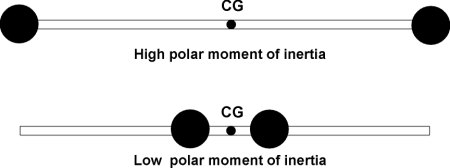
- Both of them have equal front to rear weight distribution. The one having the mass concentrating near the CG (in other words, lower polar moment of inertia) is easier to rotate about the CG. This could be easily verified by our experience. Applying the same steering force, the mid-engined car steers more quickly. The same for countering a steering action. This means it is responsive to steer and correct.
There is another advantage: since less effort is required to steer the car, we can reduce or even discard power steering, which always filter the feedback from the road thus downgrade the steering feel.
Dynamic Balance
Another reason we prefer mid-engined car is actually the slightly rear-biased weight distribution. In acceleration, we need more weight on the rear wheels to generate more traction for better launch. Obviously, FR cars are inferior in this respect. (FF cars, however, might be even better, but we shall see FF’s disadvantages later)
If acceleration is not much related to handling, braking must be very decisive. When braking into a corner, weight transfers from the rear to the front, hence actually creating unbalance to a car which achieves 50 / 50 in static condition. In contrast, a 40 / 60 mid-engined car may achieve a real dynamic balance under braking.
Neutral / Understeer / Oversteer
- We often hear these 3 terms in car magazines. I think few people would argue if I say they are the most important elements in the study of handling.
What is understeer ? Basically, if you turn the steering wheel and find the car steers less than you expect, the car is understeering. This is not because your subjective judgement goes wrong, in fact any car must have some degree of non-neutral steering due to the weight distribution, suspension design, tyre used, lateral acceleration and road conditions. Further more, a car could understeer in this corner and then oversteer in that corner. The whole picture is very complicated, so I'll spend more paragraphs to discuss this topic.
What do we need ?
It seems that neutral steer must be more desirable than understeer and oversteer, but in fact it is not.In fact, when running in straight line, we want a little bit understeer to make the car stable. When the car is subjected to side force, probably due to cross wind or the road's irregularities, understeer could resist the force and avoid the car to be steered automatically, therefore the driver need not to correct the steering frequently.
When the car is entering a corner, we also need a light understeer to provide the stability while the driver is easing off the brakes and building up cornering force. In mid corner, we need neutral steer. In the exit phase, a slight oversteer will be welcomed as it helps tightening the path. However, the degree of oversteer must be progressive and easily controllable by applying and easing throttle. We call this "Power Oversteer". Without power oversteer, we have to ease the throttle (thus loss time) or the car will run out of the corner.
However, I must make clear that what I say "slight understeer / oversteer" is usually deemed to be "near neutral steer" by most car magazines. This is because in reality there are too many cars running on severe understeer thus they used to them. In other words, if a car magazine said the Porsche 996 has mild understeer, it probably equals to "medium understeer" in our sense.
Basic Concept : Slip Angle
Before going on our study, we must understand the concept of slip angle first.When a car enters a corner, all the tyres are turned with respect to the ground. Due to the elasticity of the pneumatic tyre, the tread in the contact patch will resist the turning action because there is friction generated between the rubber and the road surface. As a result, the treads on the contact patch will be distorted, whose direction always lags behind the direction of the wheel ( See figure in below ). We call the angular difference between the treads and the wheel's direction as Slip Angle.
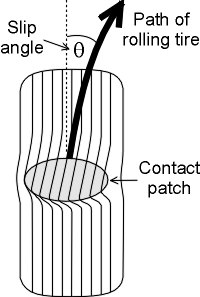
- In which direction the wheel is running ? It is the direction of the tread, not the direciton of the wheel. I am not saying the tread has any ability to force the wheel to travel in its direction. On the contrary, the tread is only a sign showing how an arbitrary point on the tyre surface travels. If the arbitrary point travels in that direction, so does the wheel which is the summation of thousands of those points.
Now you must think the existence of slip angle must reduce the car's steering angle thus leads to understeer. In fact, it is not so if everything else are perfect. Because both the front and rear tyres have more or less the same slip angles, they counter each other thus the resulting steering angle remains unaltered.
However, if the front and rear wheels have different slip angles, then we get understeer and oversteer :
- Understeer : Front Slip Angle > Rear Slip Angle
Oversteer : Front Slip Angle < Rear Slip Angle
Neutral steer : Front Slip Angle = Rear Slip Angle

Non-neutral steer due to Tractive Force
Car magazines often prefer the handling of rear-wheel-drive cars. They say FWD cars usually understeer while RWD is easier to provide power oversteer. Now, we use the concept of Slip Angle to explain this.Consider a driving wheel, which is under cornering and has created slip angle. If tractive force (that is, the pulling force from the engine) is applied, the slip angle will increase (See Figure in below). This is because the tractive force applied between the tyre and ground will distort the tread on the contact patch further.
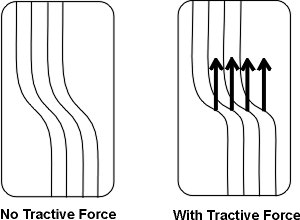
- Now the scene is clear.
- You lose time during slow down.
- You lose engine rev during slow down, thus the engine takes longer to rise back to the useful power band once you exit the corner.
- Very often, if you miscalculate, you are unlikely to have sufficient road ahead for you to slow down, especially in tight corner.
FWD cars has the front wheel's slip angle > rear wheel's. This result in Understeer.
RWD cars has the front wheel's slip angle < rear wheel's. This result in Oversteer.
4WD cars, if the front / rear torque split is equal, has equal F/R slip angles, thus result in Neutral steer.
(Remind you, understeer, oversteer and neutral also depend on suspension design, weight distribution etc. So we cannot say all FWD cars must understeer or all RWD car must oversteer. In fact, car makers usually design the suspension geometry to compensate the non-neutral steering generated by FWD / RWD and weight distribution.)
Power Oversteer and Lift-off Oversteer
The more tractive force we apply, the larger slip angle is created in the driving wheel. Therefore, for the RWD cars, we can use the throttle to control the degree of oversteer. When the car is entering a corner too fast and seems likely to run wide, we can correct its direction by increasing the throttle (not to do this before reaching the mid corner !), then the car oversteers. If we find the correction is too much, we can ease the throttle and let the car returns to neutral steer or even mild understeer, depends on the suspension design and weight distribution.Only RWD cars or rear-biased 4WD cars can do this ! In the same situation, the driver in a FWD car has nothing to do other than easing the throttle, slow down the car thus reduce the centrifugal force, and hope the car can overcome the corner. There are many disadvantages :
Therefore we always say RWD car is superior than FWD car in handling. There are, however, some well-sorted front-driver (especially some GTi) can play "lift-off oversteer", which is actually the reverse of "power oversteer" - a degree of permanent oversteer is built into the car but is only accessible when the car is pushing to the limit and with throttle disengaged. Step down the throttle again will reduce the oversteer and even back to understeer. Anyway, obviously this is still not as controllable as "power oversteer". While power oversteer can extract a lot of oversteer - actually depends on throttle - lift-off oversteer is rather limited, simply because it is impossible to build a lot of permanent oversteer to the chassis without deteriorating handling in lower speed or straight line.
Once again I have to emphasis that the power oversteer must be highly controllable by the driver, otherwise the car may lose control and spun. To make a good power oversteer car, the secret is to match the power and cornering limit perfectly at the speed concerned. If the cornering limit exceeded the power, the rear wheels will grip hard and refuse to slip. In contrast, if the cornering limit is too low or the engine torque is too high at the speed concerned, the rear end will slide severely once the throttle is pressed. Therefore, the cornering limit must be set at a level where the engine output, at the speed and road we normally want the car to power oversteer, has just sufficient power to exceed. To implement it , choose a suitable set of tyres, applying suitable amount of downforce and an adequate front / rear weight distribution is very crucial.
RWD versus 4WD
Basically, 4WD does not introduce power oversteer. However, most people still prefer it simply because it provides superior cornering grip thus improve cornering speed. As I have promised earlier in the Cornering Grip section, here I'll explain how 4WD improve cornering grip :Consider a driving wheel running in a corner. Due to the frictional force applied from the road surface, the tread in the contact patch distorts and creates slip angle. The faster the car corner, the more centrifugal force generates thus the larger the slip angle becomes. You can interpret this as the elastic distortion of the tyre generates a counter force to keep the car fighting with the centrifugal force. When the car is accelerated fast to the extent that the elasticity of the tyre reaches its limit, it could not distort anymore, thus more speed will lead to the tyre slide, and the car lose grip. This point is what we call "Cornering Limit".
A FWD or RWD car has already a lot of tyre distortion (slip angle) in the driving wheel because the tractive force is shared by only two wheels. Therefore there is not too much space left before the tyres running into their cornering limits. On the contrary, 4WD cars distribute tractive force to all wheels, thus each wheel shares considerably less tractive force thus create smaller slip angle in cornering. The car can corner at higher speed before the slip angle reach the cornering limit.
Grip aside, we concentrate back to our current topic - steering tendency.
There is always argument that whether the neutral steer of 4WD is better than RWD's oversteer. Although neutral is more favourable in the entry phase and mid corner phase during cornering, it doesn't provide the "correctability" of power oversteer in the exit phase. Remember, no driver could avoid miscalculation, no matter Mrs. Robinson or Michael Schumacher. Normally we need to feel the car's attitude and the road condition every moment before deciding how to control the car in the next moment. In this sense, RWD's controllable power oversteer is what we want.
Moreover, power oversteer of RWD ask the driver to intervene the throttle during cornering. This let him feel more involving and that he is mastering the car. In contrast, 4WD cars let the tremendous grip, the limited-slip differential and even the computer to rule the car's cornering. Therefore we always hear road testers said RWD is more fun to drive.
I am not saying 4WD cannot have power oversteer. Bugatti EB110, with its 30/70 front-to-rear torque split, did that beautifully while providing tremendous grip. Even though a 50/50 4WD car like Mitsubishi Lancer Evo V could achieve slightly power oversteer by means of well-sorted suspension geometry. For example, if the suspension is setup such that to introduce rear outside wheel positively cambers when subjective to body roll, the contact patch area decreases thus slip angle increases, then power oversteer is also available. However, you cannot set the suspension to provide power oversteer as much as RWD car since there is a trade-off in total grip and straight line stability.
New Trend for RWD cars
In the past 2 decades, we saw car makers gradually increases understeer in RWD cars, making them more "secure" to drive. Porsche 996 is a good example. Its predecessor 911 used to offer hell a lot of oversteer, now the 996 becomes a very civilised GT.This is partly due to the market orientation ( it seems the wealthy customers tend to love secure rather than excitement), partly due to the use of wider tyres. In the past 2 decades, tyres of sports cars had been widened for about 50%, in addition to the growth in diameter, the contact patch area had been largely increased. Of course this is intended to increase the grip. However, increased contact patch area means every square inches of the contact patch carries less cornering force, so the tread distort less and the slip angle is reduced.
It is known that for the range of slip angle we concern (normally less than 20°), tractive force has less influence to the narrow slip angle than the wide slip angle, as illustrated in below :
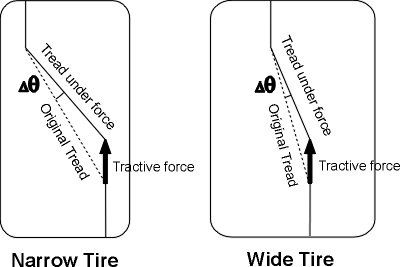
- Therefore, when apply the same power, the rear wheel slip angle increases in a lesser rate in wider tyres. In other words, power oversteer is less obvious.
This explain why the 115 hp version BMW Z3 1.9 has virtually no power oversteer ability. Its engine lacks the power to generate sufficient slip angle to the wide 205 rear tyres.
If it get considerable more power, like the M Roadster, power oversteer would have come back. But then again the car maker is very likely to install even wider rear tyres in order to cope with the increased performance, as did in the M Roadster. So once again the power oversteer is quite limited.
In my opinion, this trend is quite frustrating to the front-engined RWD cars. It makes them having less and less fun to drive, although the increased grip will ultimately improve cornering time. To mid-engined cars, whose rearward weight bias used to create some undesirable oversteer, the adoption of wider tyres could actually improve the handling and driving fun.
